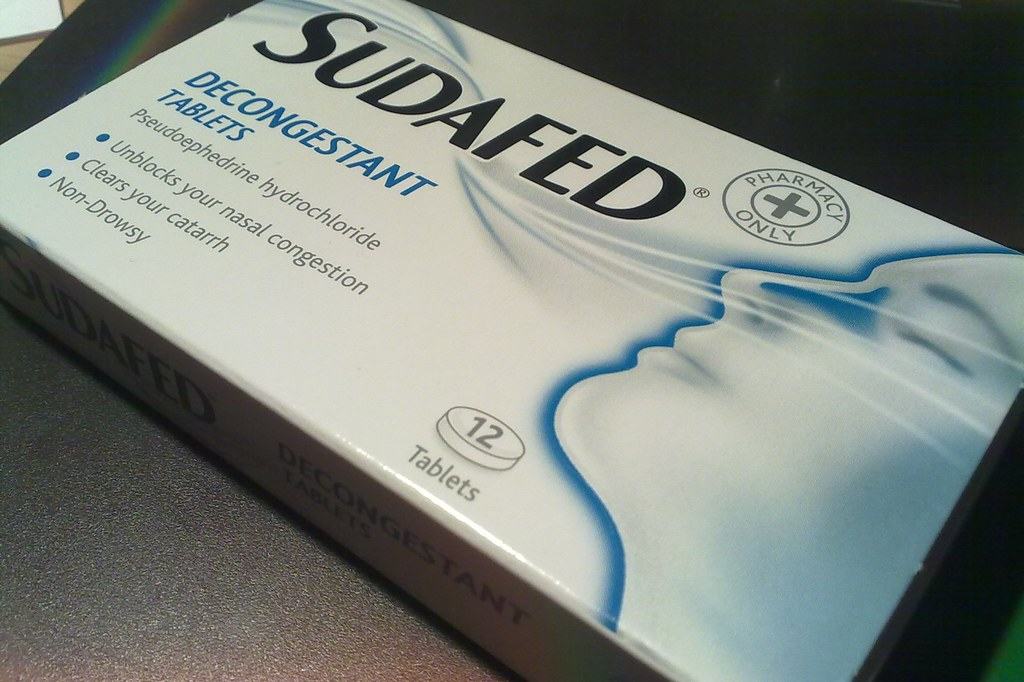5.7 Decongestants
Open Resources for Nursing (Open RN)
Pseudoephedrine is an over-the-counter (OTC) decongestant (see Figure 5.9[1]). More details regarding pseudoephedrine are described in the “Autonomic Nervous System” chapter.

Mechanism of Action
Pseudoephedrine acts directly on the adrenergic receptors and acts indirectly by releasing norepinephrine from its storage sites. The drug produces vasoconstriction, which shrinks nasal mucosa membranes.
Indications for Use
Decongestants relieve nasal obstruction due to inflammation.
Nursing Considerations Across the Lifespan
This medication is not safe for children under the age of 4 years.
Adverse/Side Effects
Common adverse/side effects include hypertension, dysrhythmia, dizziness, headache, insomnia, and restlessness. Some patients may experience blurred vision, tinnitus, chest tightness, dry nose, and nasal congestion.
Decongestants are contraindicated in patients with severe hypertension, coronary artery disease (CAD), narrow-angle glaucoma, and some antidepressant use. Also, use with caution in patients who have cardiac dysrhythmias, hyperthyroidism, DM (diabetes mellitus), prostatic hypertrophy, and glaucoma.[2]
Patient Teaching & Education
Patients must take care to follow dosing recommendations. If dosing standards are surpassed, some patients may experience side effects such as increased nervousness, breathing difficulties, heart rate changes, and hallucinations.[3]
Now let’s take a closer look at the medication grid on Pseudoephedrine in Table 5.7.[4], [5], [6]
Table 5.7 Pseudoephedrine Medication Grid
Class/Subclass |
Prototype/Generic |
Administration Considerations |
Therapeutic Effects |
Adverse/Side Effects |
|---|---|---|---|---|
| Decongestant | pseudoephedrine | Administration (drops, sprays)
Avoid prolonged use > 7 days Use cautiously with cardiovascular disease Maintain hydration (2-3 liters/day) |
Temporarily relieves nasal congestion due to the common cold, hay fever, or other upper respiratory allergies
Temporarily relieves sinus congestion and pressure |
Cardiovascular stimulation
Rebound congestion with nasal route |
- "Project 366 #165: 130612 Helping Hand?" by Pete is licensed under public domain ↵
- Frandsen, G. & Pennington, S. (2018). Abrams’ clinical drug: Rationales for nursing practice (11th ed.). Wolters Kluwer. ↵
- uCentral from Unbound Medicine. https://www.unboundmedicine.com/ucentral ↵
- This work is a derivative of Pharmacology Notes: Nursing Implications for Clinical Practice by Gloria Velarde is licensed under CC BY-NC-SA 4.0. ↵
- Frandsen, G. & Pennington, S. (2018). Abrams’ clinical drug: Rationales for nursing practice (11th ed.). Wolters Kluwer. ↵
- This work is a derivative of Daily Med by U.S. National Library of Medicine in the public domain. ↵

